section 5 ASTON MARTIN DB7 1997 Workshop Manual
[x] Cancel search | Manufacturer: ASTON MARTIN, Model Year: 1997, Model line: DB7, Model: ASTON MARTIN DB7 1997Pages: 421, PDF Size: 9.31 MB
Page 3 of 421
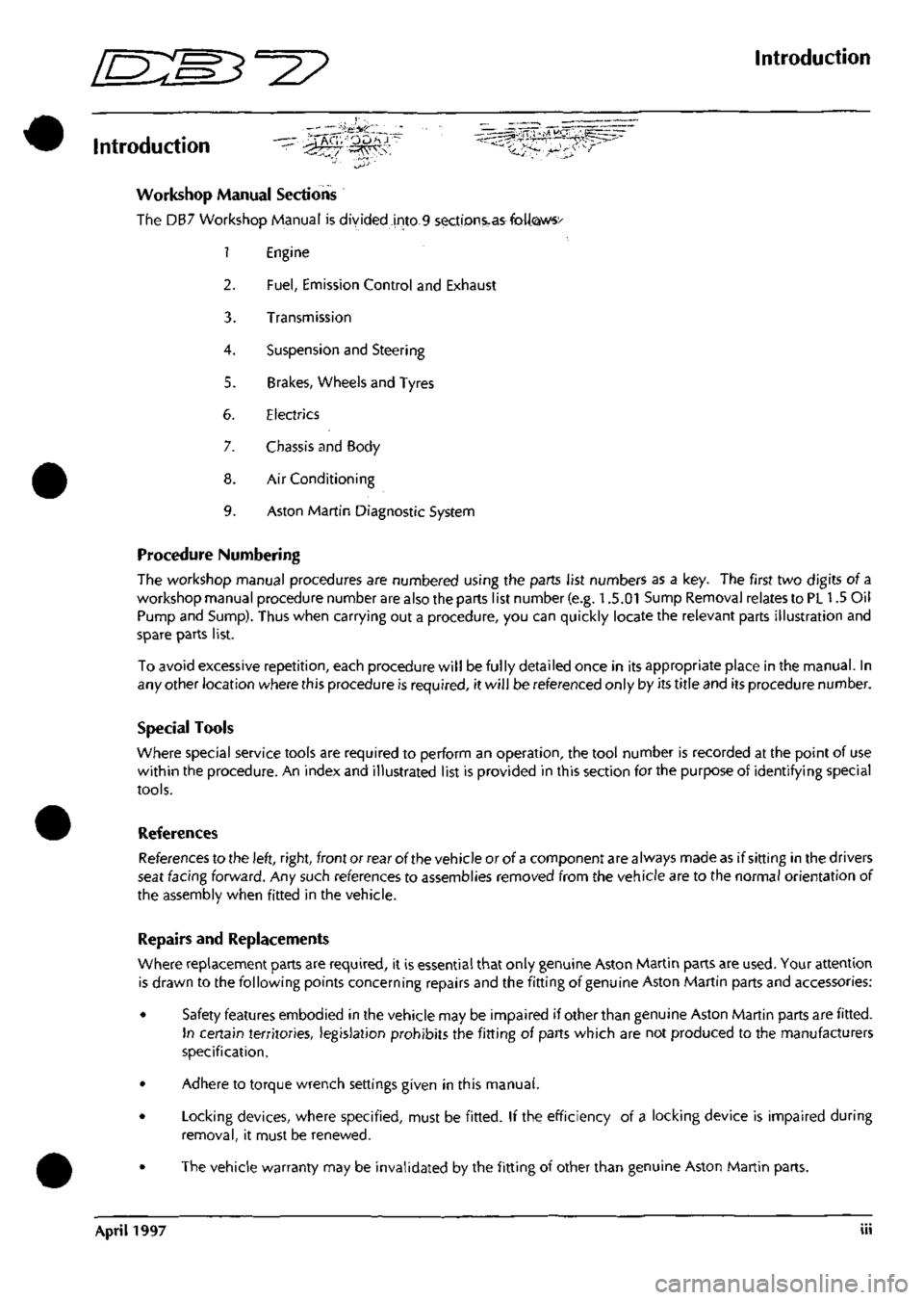
^?
Introduction
#
••t
*<;'..
Introduction '-^;^'^<-~'
^--"^^zfjj^^T^""
Workshop Manual Sections
The
DB7
Workshop Manual
is
divided .jnto,9seGtipnsE.a&foli
1 Engine
2.
Fuel,
Emission Control
and
Exhaust
3. Transmission
4.
Suspension
and
Steering
5. Brakes, Wheels
and
Tyres
6. Electrics
7. Chassis
and
Body
8.
Air
Conditioning
9. Aston Martin Diagnostic System
Procedure Numbering
The workshop manual procedures
are
numbered using
the
parts list numbers
as a key. The
first
two
digits
oi a
workshop manual procedure number
are
also
the
parts list number
(e.g.
1.5.01
Sump Removal relates
to PL 1.5 Oil
Pump
and
Sump). Thus when carrying
out a
procedure,
you can
quickly locate
the
relevant parts illustration
and
spare parts list.
To avoid excessive repetition, each procedure will
be
fully detailed once
in its
appropriate place
in the
manual.
In
any other location where this procedure
is
required,
it
will
be
referenced only
by its
title
and its
procedure number.
Special Tools
Where special service tools
are
required
to
perform
an
operation,
the
tool number
is
recorded
at the
point
of use
within
the
procedure.
An
index
and
illustrated list
is
provided
in
this section
for the
purpose
of
identifying special
tools.
References
References
to the
left, right, front
or
rear
of
the vehicle
or of
a component
are
always made as
if
sitting
in the
drivers
seat facing forward.
Any
such references
to
assemblies removed from
the
vehicle
are to the
normal orientation
of
the assembly when fitted
in the
vehicle.
Repairs
and
Replacements
Where replacement parts
are
required,
it is
essential that only genuine Aston Martin parts
are
used. Your attention
is drawn
to the
following points concerning repairs
and the
fitting
of
genuine Aston Martin parts
and
accessories:
• Safety features embodied
in the
vehicle
may be
impaired
if
other than genuine Aston Martin parts
are
fitted.
In certain territories, legislation prohibits
the
fitting
of
parts which
are not
produced
to the
manufacturers
specification.
• Adhere
to
torque wrench settings given
in
this manual.
• Locking devices, where specified, must
be
fitted.
If the
efficiency
of a
locking device
is
impaired during
removal,
it
must
be
renewed.
•
The
vehicle warranty
may be
invalidated
by the
fitting
of
other than genuine Aston Martin parts.
April
1997 Hi
Page 26 of 421
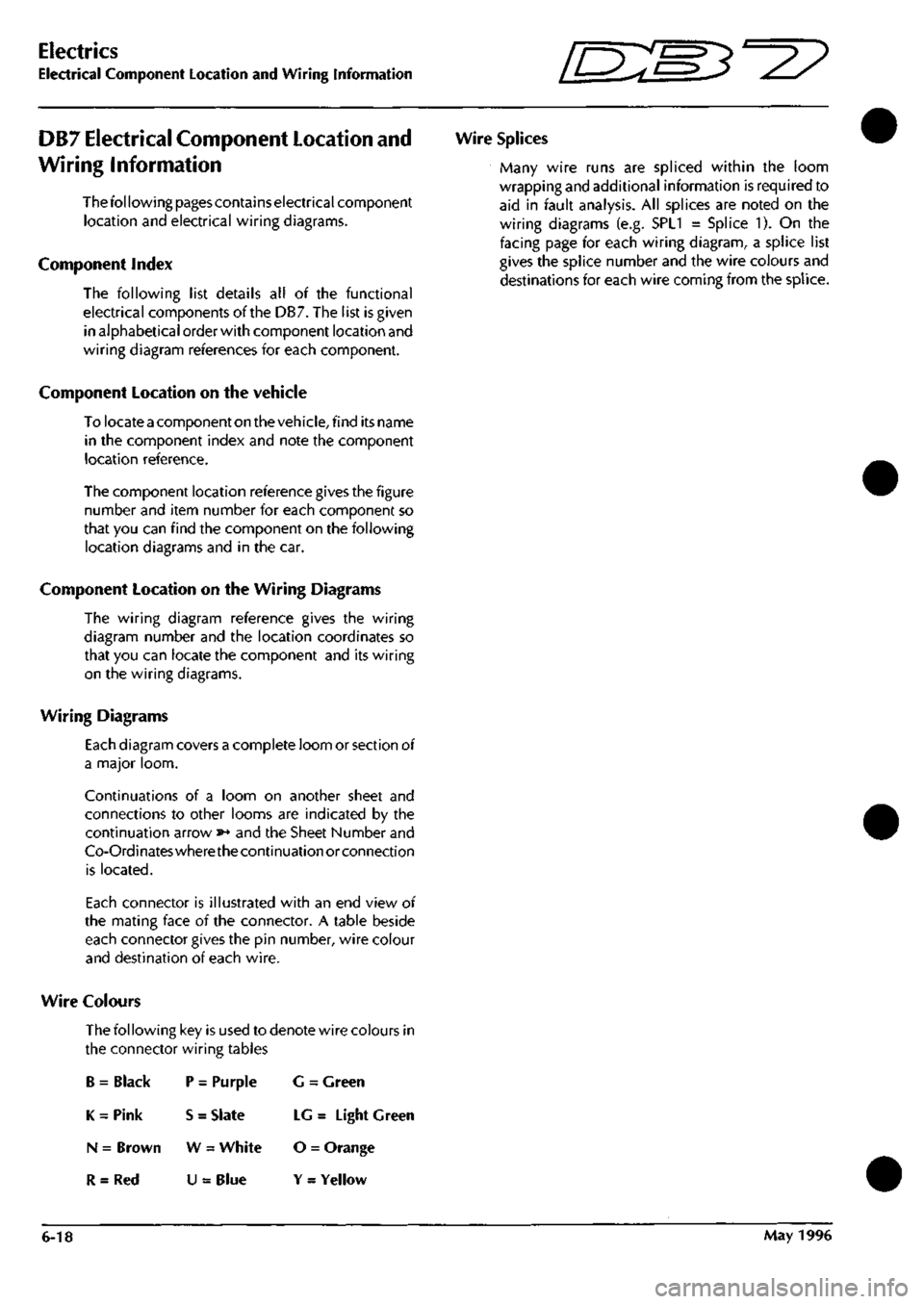
Electrics
Electrical Component Location and Wiring Information in::m3^?
DB7 Electrical Component Location and
Wiring Information
Thefol lowing pages contains electrical component
location and electrical wiring diagrams.
Component Index
The following list details all of the functional
electrical components of the DB7. The list is given
in alphabetical order with component location and
wiring diagram references for each component.
Component Location on the vehicle
To locate a component on the veh
icie,
find its name
in the component index and note the component
location reference.
The component location reference gives the figure
number and item number for each component so
that you can find the component on the following
location diagrams and in the car.
Component Location on the Wiring Diagrams
The wiring diagram reference gives the wiring
diagram number and the location coordinates so
that you can locate the component and its wiring
on the wiring diagrams.
Wiring Diagrams
Each diagram covers a complete loom or section of
a major loom.
Continuations of a loom on another sheet and
connections to other looms are indicated by the
continuation arrow »* and the Sheet Number and
Co-Ordinateswherethecontinuation or connection
is located.
Each connector is illustrated with an end view of
the mating face of the connector. A table beside
each connector gives the pin number, wire colour
and destination of each wire.
Wire Colours
The following key is used to denote wire colours in
the connector wiring tables
B = Black P = Purple G = Green
K = Pink S = Slate LG = Light Green
N = Brown W = White O = Orange
R = Red U = Blue Y = Yellow
Wire Splices
Many wire runs are spliced within the loom
wrapping and additional information is required to
aid in fault analysis. All splices are noted on the
wiring diagrams (e.g. SPL1 = Splice 1). On the
facing page for each wiring diagram, a splice list
gives the splice number and the wire colours and
destinations for each wire coming from the splice.
6-18 May 1996
Page 191 of 421
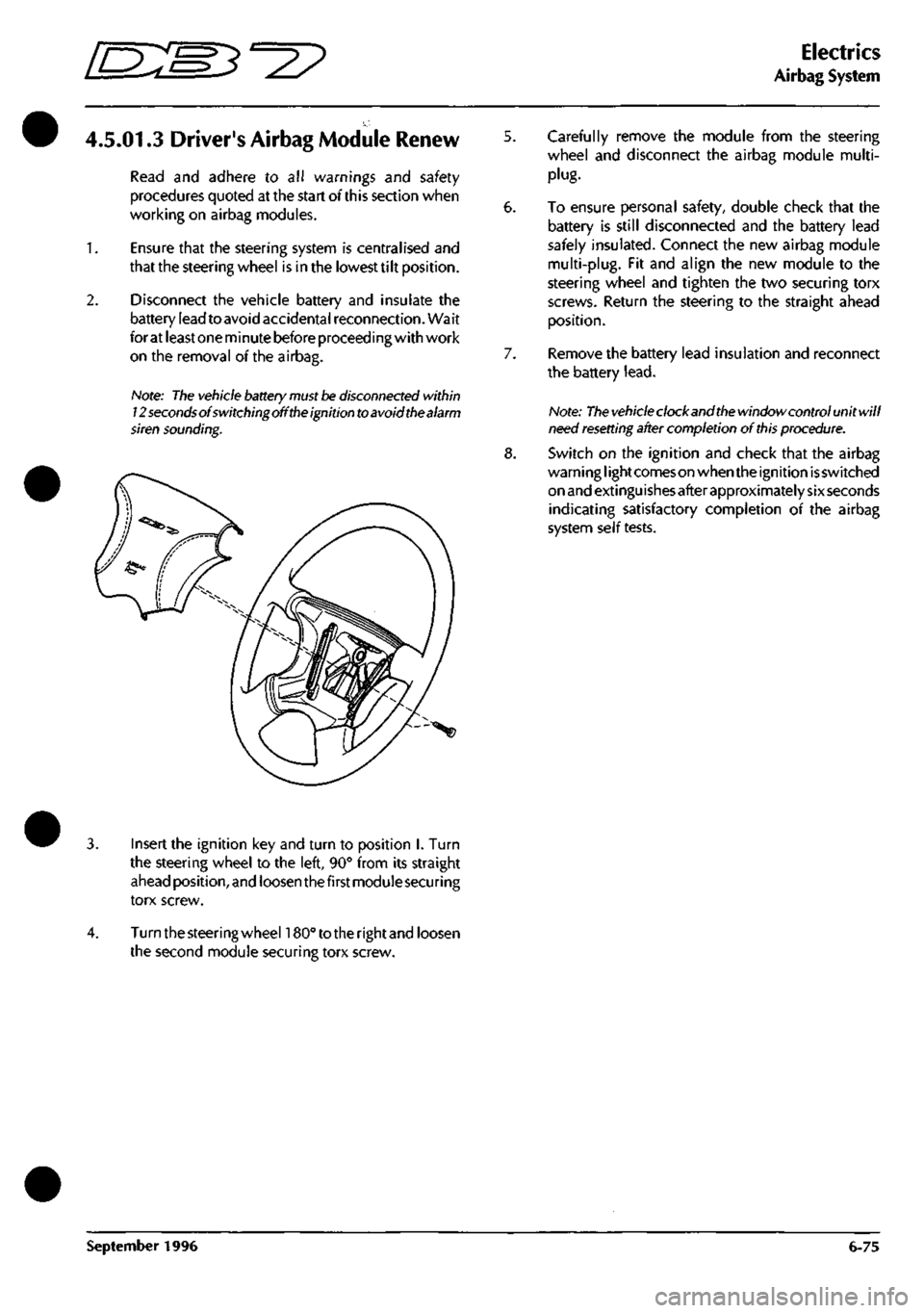
'=2?
Electrics
Airbag System
4.5.01.3 Driver's Airbag Module Renew
Read and adhere to all warnings and safety
procedures quoted at the start of this section when
working on airbag modules.
1.
Ensure that the steering system is centralised and
that the steering wheel is in the lowest tilt position.
2.
Disconnect the vehicle battery and insulate the
battery lead to avoid accidental reconnection. Wait
for at least one minute before proceeding with work
on the removal of the airbag.
Hote: The vehicle battery
must be
disconnected within
12 seconds of switching off
the
ignition to avoid the alarm
siren sounding.
5. Carefully remove the module from the steering
wheel and disconnect the airbag module multi-
plug.
6. To ensure personal safety, double check that the
battery is still disconnected and the battery lead
safely insulated. Connect the new airbag module
multi-plug.
Fit and align the new module to the
steering wheel and tighten the two securing torx
screws. Return the steering to the straight ahead
position.
7. Remove the battery lead insulation and reconnect
the battery
lead.
Note:
The vehicle
clockandthe window control unitwill
need
resetting
after completion of
this
procedure.
8. Switch on the ignition and check that the airbag
warni ng
I
ight comes on when the ignition is switched
on and extinguishes after approximately sixseconds
indicating satisfactory completion of the airbag
system self tests.
Insert the ignition key and turn to position I. Turn
the steering wheel to the left, 90° from its straight
ahead position, and loosen thefirstmoduiesecuring
torx screw.
Turn the steering wheehSO" to the rightand loosen
the second module securing torx screw.
September 1996 6-75
Page 192 of 421
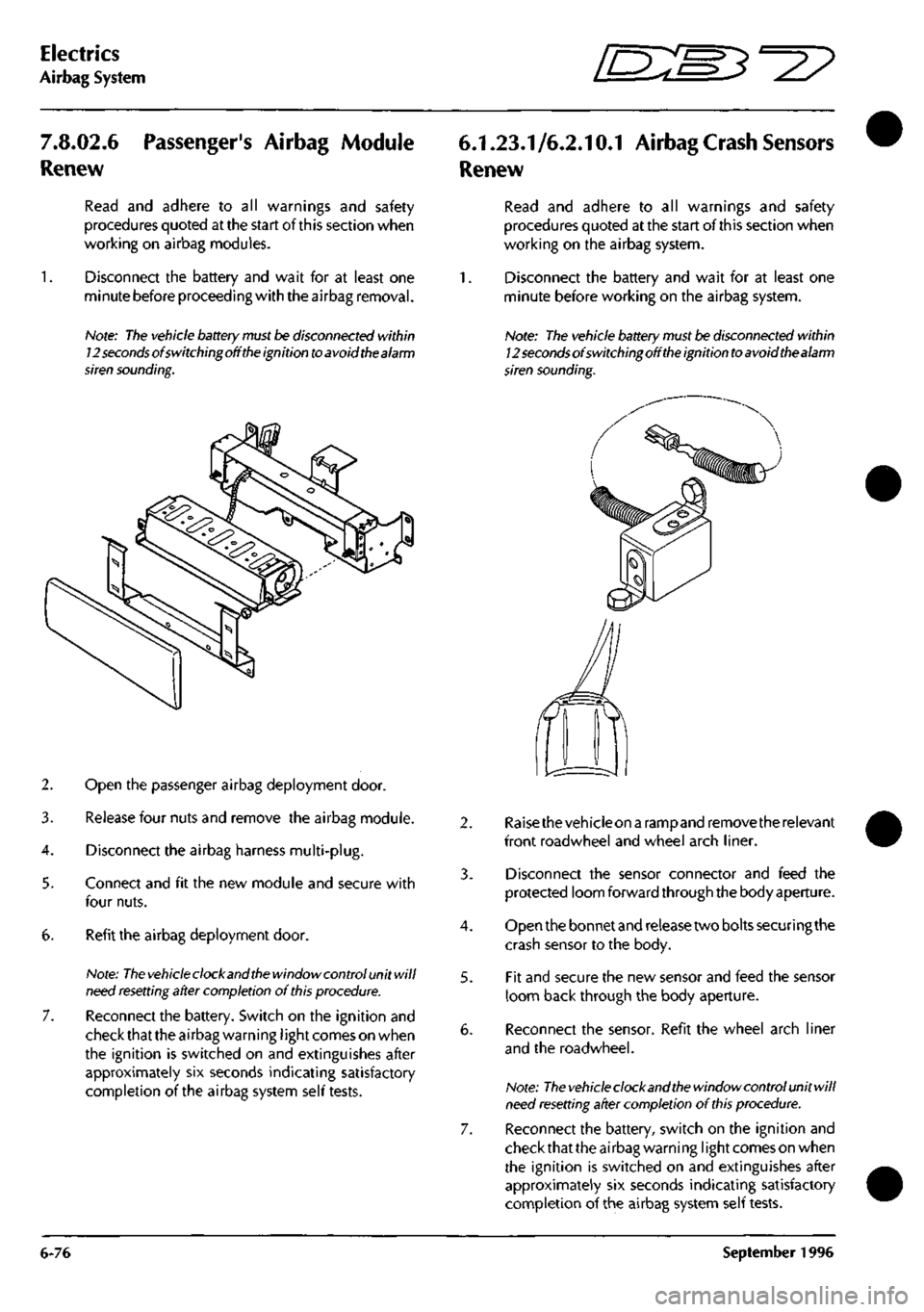
Electrics
Airbag System ^^?
7.8.02.6
Renew
Passenger's Airbag Module
Read and adhere to all warnings and safety
procedures quoted at the start of this section when
working on airbag modules.
Disconnect the battery and wait for at least one
minute before proceeding with the airbag removal.
Note:
The
vehicle battery
must
be disconnected within
12
seconds
of switchingoff
the
ignition
to
avoid the alarm
siren sounding.
2. Open the passenger airbag deployment door.
3. Release four nuts and remove the airbag module.
4.
Disconnect the airbag harness multi-plug.
5. Connect and fit the new module and secure with
four nuts.
6. Refit the airbag deployment door.
Note:
The vehicle
clock and
the
window control unit will
need
resetting
after completion of
this
procedure.
7. Reconnect the battery. Switch on the ignition and
check that the airbag warning
I
ight comes on when
the ignition is switched on and extinguishes after
approximately six seconds indicating satisfactory
completion of the airbag system self tests.
6.1.23.1/6.2.10.1 Airbag
Crash
Sensors
Renew
Read and adhere to all warnings and safety
procedures quoted at the start of this section when
working on the airbag system.
1.
Disconnect the battery and wait for at least one
minute before working on the airbag system.
Note: The vehicle
battery
must be disconnected within
12
seconds
of switchingoff
the
ignition
to
avoid thealarm
siren sounding.
4.
5.
Raisethevehicleon a rampand remove the relevant
front roadwheel and wheel arch liner.
Disconnect the sensor connector and feed the
protected loom forward through the body aperture.
Open the bonnet and release two bolts securing the
crash sensor to the body.
Fit and secure the new sensor and feed the sensor
loom back through the body aperture.
Reconnect the sensor. Refit the wheel arch liner
and the roadwheel.
Note:
The vehicle
clock and
the
window control unit will
need
resetting
after completion of
this
procedure.
Reconnect the battery, switch on the ignition and
check that the airbag warning
I
ight comes on when
the ignition is switched on and extinguishes after
approximately six seconds indicating satisfactory
completion of the airbag system self tests.
6-76 September 1996
Page 193 of 421
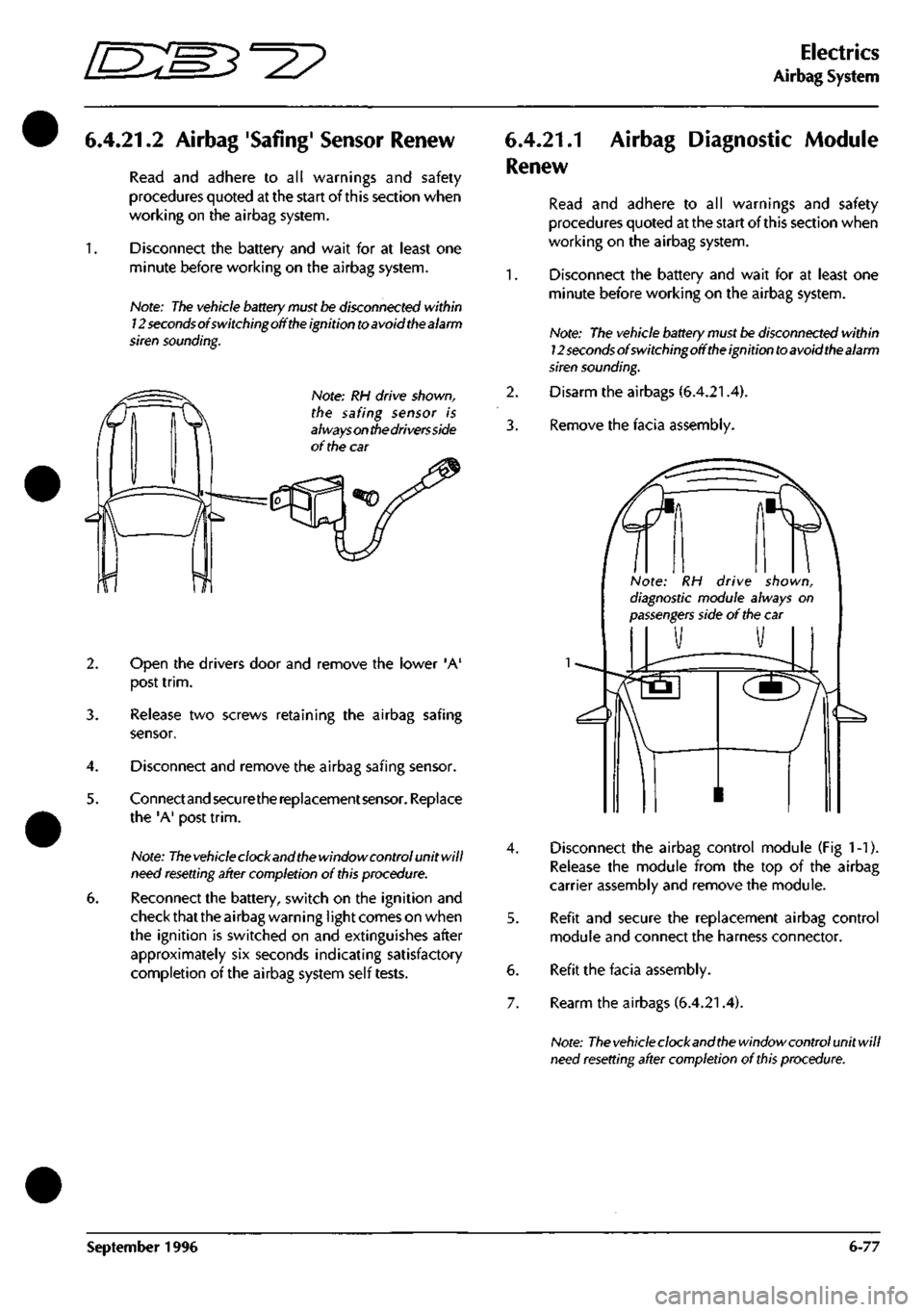
^7
Electrics
Airbag System
6.4.21.2
Airbag 'Safing' Sensor Renew
Read and adhere to all warnings and safety
procedures quoted at the start of this section when
working on the airbag system.
1.
Disconnect the battery and wait for at least one
minute before working on the airbag system.
Note:
The
vehicle battery must be disconnected within
12 secondsofswitchingoffthe ignition to avoid the alarm
siren sounding.
^h
Note: RH drive shown,
the safing sensor is
always
on
the drivers side
of the car
2. Open the drivers door and remove the lower 'A'
post
trim.
3. Release two screws retaining the airbag safing
sensor.
4.
Disconnect and remove the airbag safing sensor.
5. Connectand securethe replacement sensor. Replace
the 'A' post
trim.
Note:
The
vehicle clock and
the
window control unit will
need
resetting
after completion of
this
procedure.
6. Reconnect the battery, switch on the ignition and
check that the airbag warning
I
ight comes on when
the ignition is switched on and extinguishes after
approximately six seconds indicating satisfactory
completion of the airbag system self tests.
6.4.21.1
Renew
Airbag Diagnostic Module
1.
2.
3.
4.
6.
7.
Read and adhere to all warnings and safety
procedures quoted at the start of this section when
working on the airbag system.
Disconnect the battery and wait for at least one
minute before working on the airbag system.
Note: The vehicle battery must
be
disconnected within
l2secondsofswitchingofftheignitiontoavoidthealarm
siren
sounding.
Disarm the airbags (6.4.21.4).
Remove the facia assembly.
Note: RH drive shown,
diagnostic module always on
passengers
side of
the
car
Disconnect the airbag control module (Fig 1-1).
Release the module from the top of the airbag
carrier assembly and remove the module.
Refit and secure the replacement airbag control
module and connect the harness connector.
Refit the facia assembly.
Rearm the airbags (6.4.21.4).
Note:
The
vehicle clock and
the
window control unit will
need
resetting
after completion of this procedure.
September 1996 6-77
Page 196 of 421
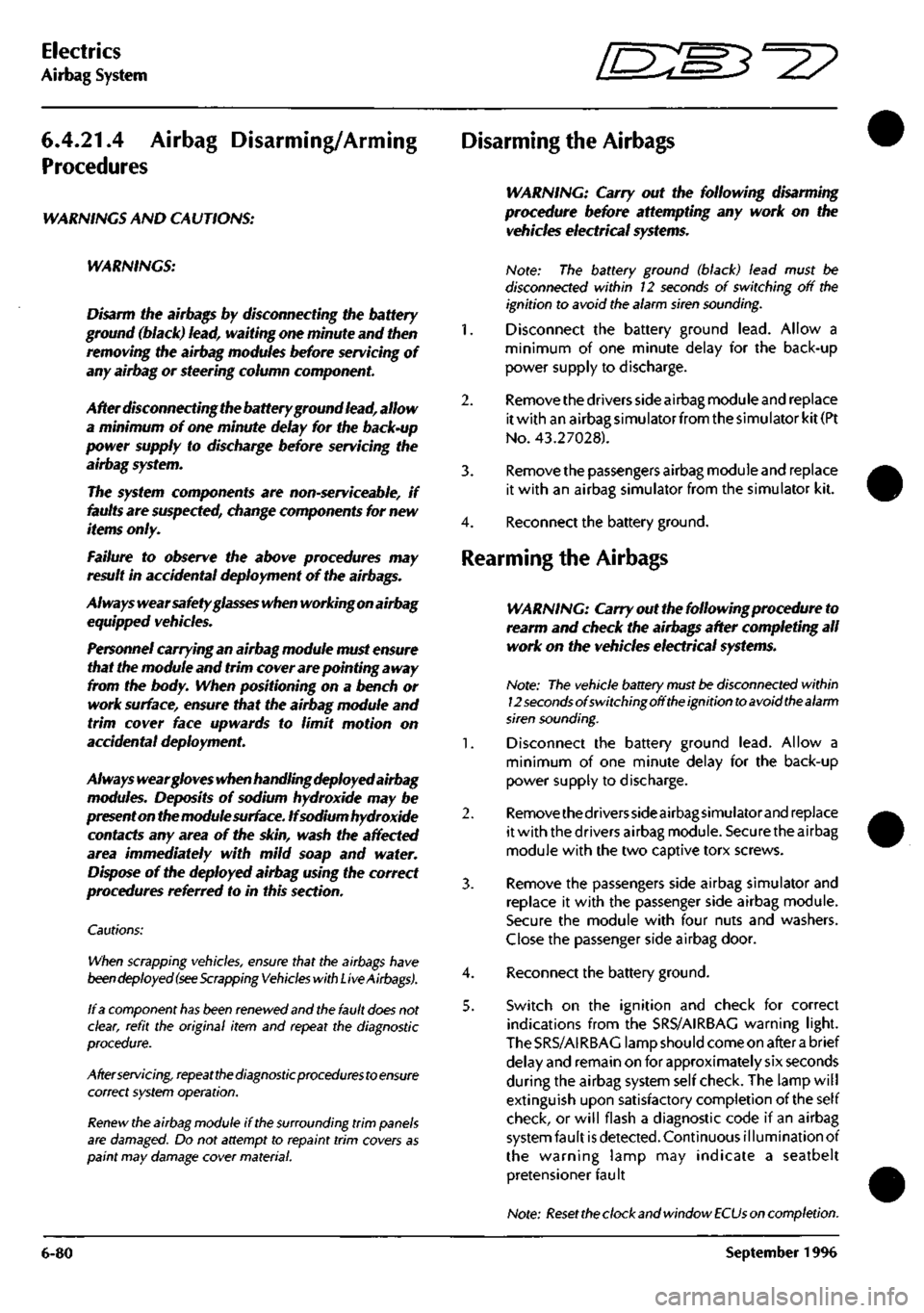
Electrics
Airbag System ^2?
6.4.21.4
Airbag Disarming/Arming
Procedures
WARNINGS AND CAUTIONS:
WARNINGS:
Disarm the airbags by disconnecting the battery
ground (black)
lead,
waiting one minute and then
removing the airbag modules before servicing of
any airbag or steering column component.
After disconnecting the battery ground
lead,
allow
a minimum of one minute delay for the back-up
power supply to discharge before servicing the
airbag system.
The system components are non-serviceable, if
faults are
suspected,
change components for new
items
only.
Failure to observe the above procedures may
result in accidental deployment of the airbags.
Always wear safety
glasses
when working on airbag
equipped vehicles.
Personnel carrying an airbag module must ensure
that the module and trim cover are pointing away
from the
body.
When positioning on a bench or
work surface, ensure that the airbag module and
trim cover face upwards to limit motion on
accidental deployment.
Always wear
gloves
when handling deployed airbag
modules. Deposits of sodium hydroxide may be
presenton the module surface. If sodium hydroxide
contacts any area of the skin, wash the affected
area immediately with mild soap and
water.
Dispose of the deployed airbag using the correct
procedures referred to in this section.
Cautions:
When scrapping vehicles,
ensure
that the
airbags
have
been deployed (see
Scrapping Vehicles
with Live
Airbags).
If a component
has been
renewed and the fault
does
not
clear,
refit the original item and repeat the diagnostic
procedure.
After
servicing,
repeatthe diagnostic
procedures
to ensure
correct
system
operation.
Renew
the airbag module if the surrounding trim
panels
are
damaged.
Do not attempt to repaint trim covers as
paint may
damage
cover material.
Disarming the Airbags
3.
4.
WARNING: Carry out the following disarming
procedure before attempting any work on the
vehicles electrical
systems.
Note: The battery ground (black) lead must be
disconnected within 12 seconds of switching off the
ignition to avoid the alarm siren sounding.
Disconnect the battery ground
lead.
Allow a
minimum of one minute delay for the back-up
power supply to discharge.
Remove the drivers side airbag module and replace
it with an airbag simulatorfrom the simulator kit (Pt
No.
43.27028).
Remove the passengers airbag module and replace
it with an airbag simulator from the simulator kit.
Reconnect the battery ground.
Rearming the Airbags
WARNING: Carry out the following procedure to
rearm and check the airbags after completing all
work on the vehicles electrical
systems.
Note: The vehicle battery
must be
disconnected within
12
seconds
of switching off
the
ignition
to
avoid the alarm
siren sounding.
^. Disconnect the battery ground
lead.
Allow a
minimum of one minute delay for the back-up
power supply to discharge.
2.
Removethedriverssideairbagsimulatorand replace
it with the drivers airbag module. Secure the airbag
module with the two captive torx screws.
3. Remove the passengers side airbag simulator and
replace it with the passenger side airbag module.
Secure the module with four nuts and washers.
Close the passenger side airbag door.
4.
Reconnect the battery ground.
5. Switch on the ignition and check for correct
indications from the SRS/AIRBAG warning light.
TheSRS/AIRBAC lamp should come on after
a
brief
delay and remain on for approximately six seconds
during the airbag system self check. The lamp will
extinguish upon satisfactory completion of the self
check, or will flash a diagnostic code if an airbag
system fault is detected. Continuous illumination of
the warning lamp may indicate a seatbelt
pretensioner fault
Note:
Reset the
clock and window
ECUs
on completion.
6-80 September 1996
Page 199 of 421
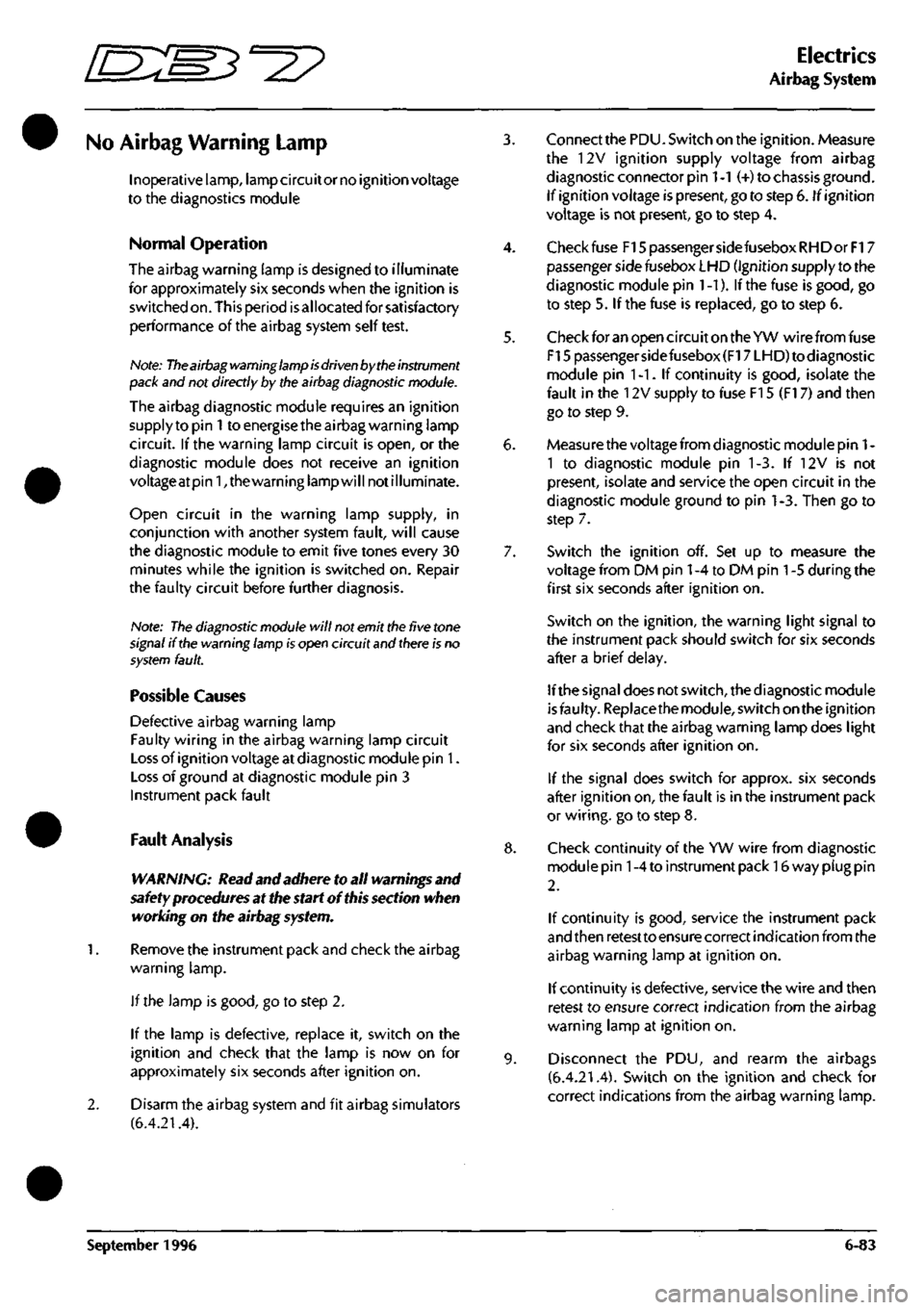
"^p
Electrics
Airbag System
No Airbag Warning Lamp
I
noperative lamp, lamp ci rcu it or no ign ition voltage
to the diagnostics module
Normal Operation
The airbag warning lamp is designed to illuminate
for approximately six seconds when the ignition is
switched
on.
This period
is
allocated for satisfactory
performance of the airbag system self test.
Note: The a irbag warning lamp is
driven
by
the instrument
pack and not directly by the airbag diagnostic module.
The airbag diagnostic module requires an ignition
supply to pin
1
to energise the airbag warning lamp
circuit. If the warning lamp circuit is open, or the
diagnostic module does not receive an ignition
voltageatpini, the warning lamp will not illuminate.
Open circuit in the warning lamp supply, in
conjunction with another system fault, will cause
the diagnostic module to emit five tones every 30
minutes while the ignition is switched on. Repair
the faulty circuit before further diagnosis.
Note:
The
diagnostic module will not emit
the
five tone
signal if the warning lamp
is
open circuit and
there
is no
system
fault.
Possible Causes
Defective airbag warning lamp
Faulty wiring in the airbag warning lamp circuit
Loss of ignition voltage at diagnostic module pin 1.
Loss of ground at diagnostic module pin 3
Instrument pack fault
Fault Analysis
WARNING: Read and adhere to all warnings and
safety procedures at the start of this section when
working on the airbag
systent.
1.
Remove the instrument pack and check the airbag
warning lamp.
If the lamp is good, go to step 2.
If the lamp is defective, replace it, switch on the
ignition and check that the lamp is now on for
approximately six seconds after ignition on.
2.
Disarm the airbag system and fit airbag simulators
(6.4.21.4).
9.
Connect the PDU. Switch on the ignition. Measure
the 12V ignition supply voltage from airbag
diagnostic connector pin
1 -1
{+) to chassis ground.
If ignition voltage is present, go to step 6. If ignition
voltage is not present, go to step 4.
Checkfuse F15passengersidefuseboxRHDorF17
passenger side fusebox LHD (Ignition supply to the
diagnostic module pin
1
-1). If the fuse is good, go
to step 5. If the fuse is replaced, go to step 6.
Check for an open circuit on the YW wire from fuse
F15 passenger sidefusebox(F17 LHD)todiagnostic
module pin 1-1. If continuity is good, isolate the
fault in the 12V supply to fuse Fl 5 (Fl 7) and then
go to step 9.
Measure the voltage from diagnostic module pin
1
-
1 to diagnostic module pin 1-3. If 12V is not
present, isolate and service the open circuit in the
diagnostic module ground to pin 1-3. Then go to
step 7.
Switch the ignition off. Set up to measure the
voltage from DM pin
1
-4 to DM pin
1
-5 during the
first six seconds after ignition on.
Switch on the ignition, the warning light signal to
the instrument pack should switch for six seconds
after a brief delay.
If the signal does not switch, the diagnostic module
is
fau Ity. Replace the modu
le,
switch on the ign ition
and check that the airbag warning lamp does light
for six seconds after ignition on.
If the signal does switch for approx. six seconds
after ignition on, the fault is in the instrument pack
or wiring, go to step 8.
Check continuity of the YW wire from diagnostic
module pin
1
-4 to instrument pack 16 way plug pin
2.
If continuity is good, service the instrument pack
and then retesttoensure correct indication from the
airbag warning lamp at ignition on.
If continuity is defective, service the wire and then
retest to ensure correct indication from the airbag
warning lamp at ignition on.
Disconnect the PDU, and rearm the airbags
(6.4.21.4). Switch on the ignition and check for
correct indications from the airbag warning lamp.
September 1996 6-83
Page 200 of 421
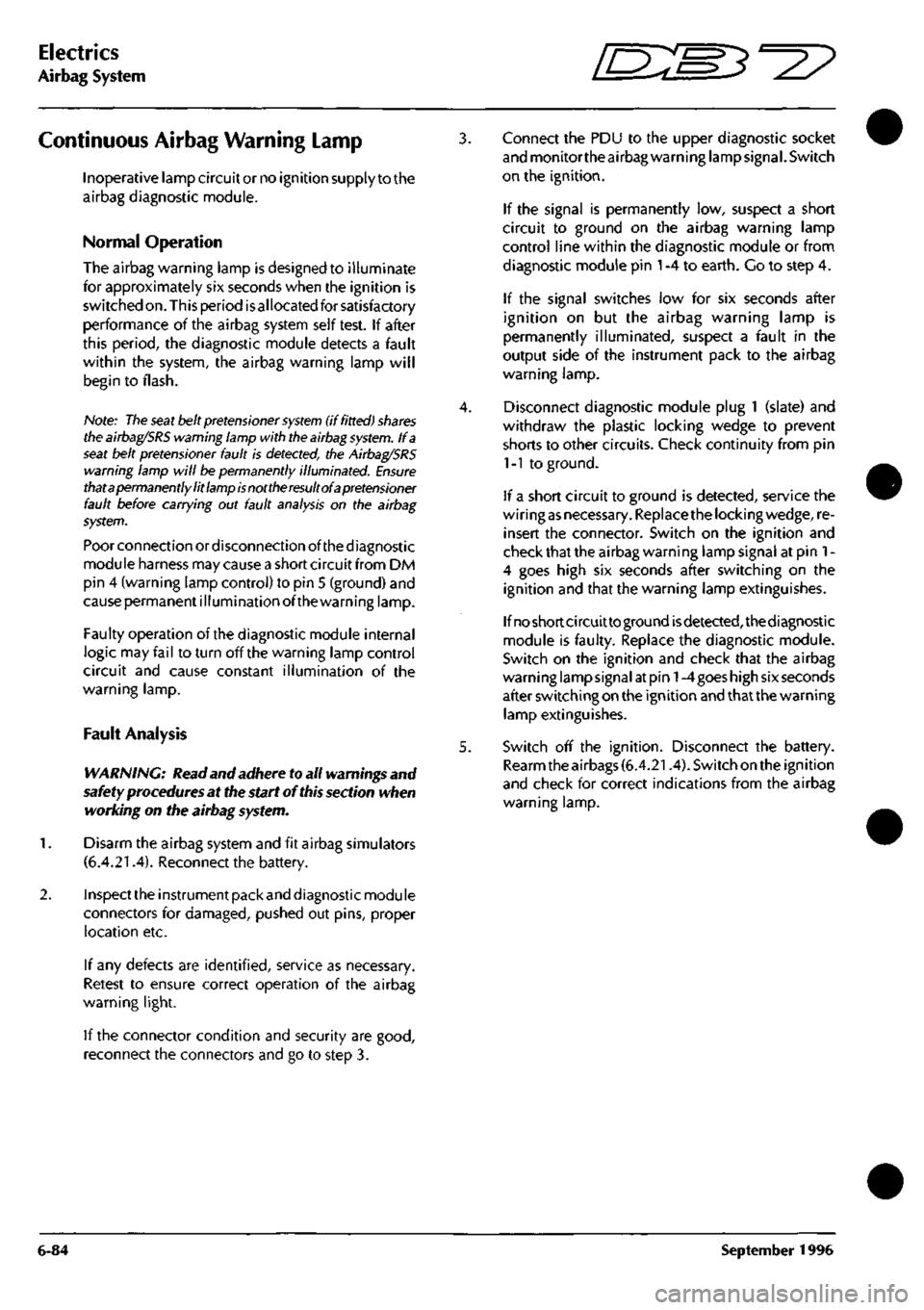
Electrics
Airbag System [EE:^^^?
Continuous Airbag Warning Lamp
Inoperative lamp circuit or no ignition supply to the
airbag diagnostic module.
Normal Operation
The airbag warning lamp is designed to illuminate
for approximately six seconds when the ignition is
switched
on.
This period isallocated for satisfactory
performance of the airbag system self test. If after
this period, the diagnostic module detects a fault
within the system, the airbag warning lamp will
begin to flash.
Note:
The seat
belt
pretensioner system
(if fitted)
shares
the
airbag/SRS
warning lamp with
the airbag
system.
If a
seat belt pretensioner fault is
detected,
the
Airbag/SRS
warning lamp will be permanently illuminated. Ensure
thata permanently lit
lamp
is nottheresultof a pretensioner
fault before carrying out fault analysis on the airbag
system.
Poor connection or disconnection of the diagnostic
module harness may cause a short circuit from DM
pin 4 (warning lamp control) to pin 5 (ground) and
cause permanent illumination ofthe warning lamp.
Faulty operation of the diagnostic module internal
logic may fail to turn off the warning lamp control
circuit and cause constant illumination of the
warning lamp.
Fault Analysis
WARNING: Read and adhere to all warnings and
safety procedures at the start of this section when
working on the airbag system.
1.
Disarm the airbag system and fit airbag simulators
(6.4.21.4). Reconnect the battery.
2.
Inspectthe instrument pack and diagnostic module
connectors for damaged, pushed out pins, proper
location etc.
If any defects are identified, service as necessary.
Retest to ensure correct operation of the airbag
warning light.
If the connector condition and security are good,
reconnect the connectors and go to step 3.
5.
Connect the PDU to the upper diagnostic socket
and monitorthe airbag warning lamp
signal.
Switch
on the ignition.
If the signal is permanently low, suspect a short
circuit to ground on the airbag warning lamp
control line within the diagnostic module or from
diagnostic module pin
1
-4 to earth. Co to step 4.
If the signal switches low for six seconds after
ignition on but the airbag warning lamp is
permanently illuminated, suspect a fault in the
output side of the instrument pack to the airbag
warning lamp.
Disconnect diagnostic module plug 1 (slate) and
withdraw the plastic locking wedge to prevent
shorts to other circuits. Check continuity from pin
1-1 to ground.
If a short circuit to ground is detected, service the
wiring
as
necessary. Replacethe locking
wedge,
re
insert the connector. Switch on the ignition and
check that the airbag warning lamp signal atpin 1-
4 goes high six seconds after switching on the
ignition and that the warning lamp extinguishes.
If no short circuitto ground isdetected,thediagnostic
module is faulty. Replace the diagnostic module.
Switch on the ignition and check that the airbag
warning lamp signal at pin
1
-4 goes high six seconds
after switching on the ignition and that the warning
lamp extinguishes.
Switch off the ignition. Disconnect the battery.
Rearm the airbags (6.4.21.4). Switch on the
ign
ition
and check for correct indications from the airbag
warning lamp.
6-84 September 1996
Page 201 of 421
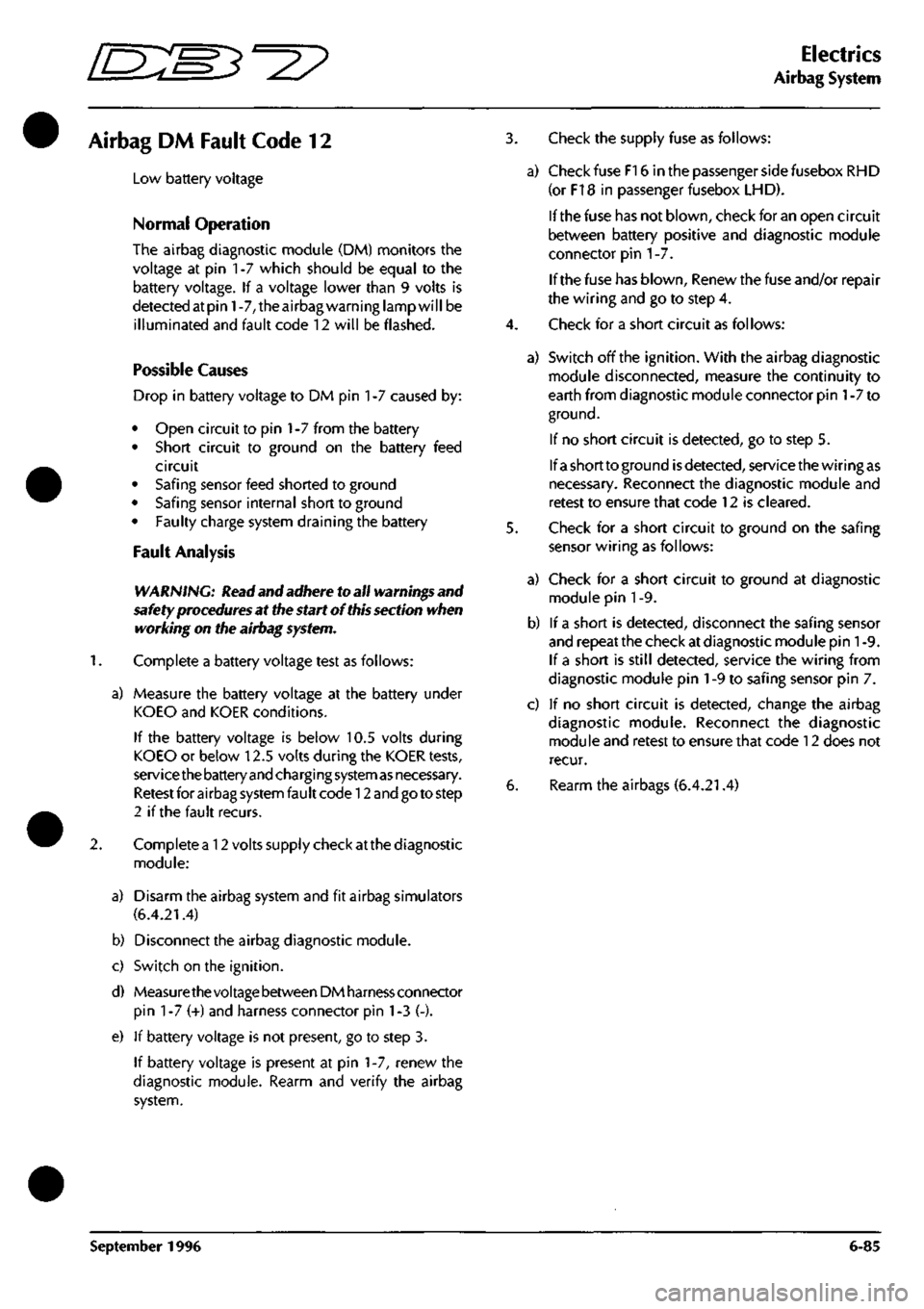
^^?
Electrics
Airbag System
Airbag DM Fault Code 12
Low battery voltage
Normal Operation
The airbag diagnostic module (DM) monitors the
voltage at pin 1-7 which should be equal to the
battery voltage. If a voltage lower than 9 volts is
detected at pin 1-7, the airbag warning lamp will be
illuminated and fault code 12 will be flashed.
Possible Causes
Drop in battery voltage to DM pin 1-7 caused by:
• Open circuit to pin
1
-7 from the battery
• Short circuit to ground on the battery feed
circuit
• Safing sensor feed shorted to ground
• Safing sensor internal short to ground
• Faulty charge system draining the battery
Fault Analysis
WARNING: Read and adhere to all warnings and
safety procedures at the start of
this
section when
working on the airbag system.
1.
Complete a battery voltage test as follows:
a) Measure the battery voltage at the battery under
KOEO and KOER conditions.
If the battery voltage is below 10.5 volts during
KOEO or below 12.5 volts during the KOER tests,
service the battery
and
charging system
as
necessary.
Retest for airbag system fau
It
code 12 and go to step
2 if the fault recurs.
2.
Complete a 12 volts supply check at the diagnostic
module:
a) Disarm the airbag system and fit airbag simulators
(6.4.21.4)
b) Disconnect the airbag diagnostic module.
c) Switch on the ignition.
d) Measurethevoltagebetween DM hamessconnector
pin 1-7 (+) and harness connector pin 1-3 (-).
e) If battery voltage is not present, go to step 3.
If battery voltage is present at pin 1-7, renew the
diagnostic module. Rearm and verify the airbag
system.
3. Check the supply fuse as follows:
a) Check fuse F16 in the passenger side fusebox RHD
(or F18 in passenger fusebox LHD).
If the fuse has not blown, check for an open circuit
between battery positive and diagnostic module
connector pin
1
-7.
If the fuse has blown. Renew the fuse and/or repair
the wiring and go to step 4.
4.
Check for a short circuit as follows:
a) Switch off the ignition. With the airbag diagnostic
module disconnected, measure the continuity to
earth from diagnostic module connector pin
1
-7 to
ground.
If no short circuit is detected, go to step 5.
Ifashortto ground isdetected, service the wiring as
necessary. Reconnect the diagnostic module and
retest to ensure that code 12 is cleared.
5. Check for a short circuit to ground on the safing
sensor wiring as follows:
a) Check for a short circuit to ground at diagnostic
module pin 1-9.
b) If a short is detected, disconnect the safing sensor
and repeat the check at diagnostic module pin
1
-9.
If a short is still detected, service the wiring from
diagnostic module pin
1
-9 to safing sensor pin 7.
c) If no short circuit is detected, change the airbag
diagnostic module. Reconnect the diagnostic
module and retest to ensure that code 12 does not
recur.
6. Rearm the airbags (6.4.21.4)
September 1996 6-85
Page 202 of 421

Electrics
Airbag System ^2?
Airbag DM Fault Code 13
Airbag circuit short to ground
Normal Operation
The diagnostic modu
le
measures the voltage at pins
2-5 and 2-6. The voltage at these pins is dependant
on charging system voltage as shown in the table
belovi-.
'in 2-5
2.3V
2.4 V
2.5V
2.7V
2.8V
3.0V
3.1V
3.2V
3.4V
3.5V
3.7V
3.8V
4.0V
4.1V
4.3V
Pin 2-6
2.3V
2.4V
2.5V
2.7V
2.8V
3.0V
3.1V
3.2V
3.4V
3.5V
3.7V
3.8V
4.0V
4.1V
4.3V
Charge Volts
9.0V
9.5V
lO.OV
10.5V
11.OV
11.5V
12.0V
12.5V
13.0V
13.5V
14.0V
14.5V
15.0V
15.5V
16.0V
If the diagnostic monitor measures a voltage of 2.0
volts or less on pins 2-5 and 2-6, a fau It code 13 will
be generated and flashed to the instrument pack to
be signalled on the airbag warning lamp. Voltages
as low as 2.0 volts indicate a possible short to
ground in these circuits.
When generating a code 13 the diagnostic module
also generates a signal to blow its own internal
thermal fuse. This action disables the airbag
deployment circuit. The airbag diagnostic module
fuse is non-repairable and the module must be
replaced after repairing the short circuit, if the
voltage at pins 2-5 and 2-6 returns to normal, fault
code 51 (blown thermal fuse) will be stored in
memory.
6.
Fault Analysis
WARNING: Read and adhere to all warnings and
safety procedures at the start of this section when
working on the airbag
system.
Disarm the airbag system and fit airbag simulators
(6.4.21.4)
Disconnect the airbag diagnostic module. Switch
on the ignition.
Measure the continuity to ground at the following
pins on the diagnostic module harness connector:
2-2 Passenger airbag feed
2-3 Passenger airbag return
2-4 Drivers airbag return
2-5 Drivers airbag feed
2-11 Safing sensor feed
If no short circuit is detected, go to step 4.
If
a
short circuit is detected, disconnect the relevant
airbag simulator or the safing sensor and repeat the
continuity measurement to isolate the circuit fault.
Service the wiring or replace the safing sensor as
necessary. Fit a new airbag diagnostic module and
rearm the airbags (6.4.21.4).
Check for intermittent short circuits in the cable
reel cassette. Monitor the continuity to ground at
pins 2-4 and 2-5 whilst rotating the steering from
lock to lock in both directions.
If no short circuit is detected, go to step 5.
If a short circuit is detected, replace the column
switchgear assembly. Fit a new airbag diagnostic
module and rearm the airbags (6.4.21.4).
WARNING: Do not attempt to make any electrical
measurements on the airbag
modules.
Any induced
voltage can
cause
the airbag
to
deploy with the
risk
of personal
injury.
Fit a replacement diagnostic module and
replacement airbag modules.
Caution: Do not refit
the
old
airbag
modules.
They may
be faulty and would
damage the
new diagnostic module.
Rearm the airbag system (6.4.21.4).
6-86 September 1996